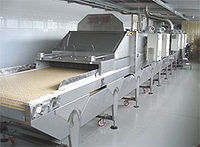Difference between revisions of "Microwave Ovens"
(Created page with "Category:Heating{{Knoppen}} <noinclude><!------------------------------------------------ * READ THIS FIRST * Only edit this page if you can improve the content. * Improper ...") |
PurplePen19 (talk | contribs) |
||
| Line 7: | Line 7: | ||
* Please start editing this page after the /noinclude | * Please start editing this page after the /noinclude | ||
* -------------------------------------------------></noinclude> | * -------------------------------------------------></noinclude> | ||
This | [[File:Microwave Ovens.jpg|thumb|200px|right|Microwave Ovens]] | ||
'''Microwave Ovens''' are used in large industries that are engaged with bulk heating and drying. These ovens are equipped with an electric control system, which is an integration of digital circuit, analog circuit and the programmable controller, and the comprehensive microwave transmission system (including the large power circulator, reflective power absorption load, and Electro-motivated stub tuner.) It has such diversified advantages as high stability of output, programmable auto-adjustment of the output power, which enables it to be the first option for microwave applications in industry and laboratory. | |||
==Industrial Microwave System vs. Home Microwave Oven== | |||
The home/restaurant batch-type ovens available to date employ a relatively low power source as compared to the industrial power source. This makes producing products beyond pilot scale levels very labor intensive. In addition, the typical home oven is considerably less efficient, up to 25% less, in converting electrical energy into microwave energy. By comparison the industrial oven can be designed as either a batch or as a continuous system with much higher power and greatly increased throughputs, reducing the amount of handling required. In addition, a forced air system can also be employed, which greatly improves moisture removal in drying applications. | |||
The system employs a high energy power source with long life. | |||
The system has a unique internal protection feature (patented) that traps stray microwaves, thus making the system completely safe to operate. A new exclusive type of forced-air system used in conjunction with microwave energy (patented) accelerates the removal of moisture quickly and efficiently. | |||
A straight-through conveyor assures uniform exposure to the microwaves. | |||
Because of its high processing capacity, unit costs are much lower than with the batch process | |||
Latest revision as of 00:30, 28 August 2012
Microwave Ovens are used in large industries that are engaged with bulk heating and drying. These ovens are equipped with an electric control system, which is an integration of digital circuit, analog circuit and the programmable controller, and the comprehensive microwave transmission system (including the large power circulator, reflective power absorption load, and Electro-motivated stub tuner.) It has such diversified advantages as high stability of output, programmable auto-adjustment of the output power, which enables it to be the first option for microwave applications in industry and laboratory.
Industrial Microwave System vs. Home Microwave Oven
The home/restaurant batch-type ovens available to date employ a relatively low power source as compared to the industrial power source. This makes producing products beyond pilot scale levels very labor intensive. In addition, the typical home oven is considerably less efficient, up to 25% less, in converting electrical energy into microwave energy. By comparison the industrial oven can be designed as either a batch or as a continuous system with much higher power and greatly increased throughputs, reducing the amount of handling required. In addition, a forced air system can also be employed, which greatly improves moisture removal in drying applications. The system employs a high energy power source with long life.
The system has a unique internal protection feature (patented) that traps stray microwaves, thus making the system completely safe to operate. A new exclusive type of forced-air system used in conjunction with microwave energy (patented) accelerates the removal of moisture quickly and efficiently.
A straight-through conveyor assures uniform exposure to the microwaves.
Because of its high processing capacity, unit costs are much lower than with the batch process
